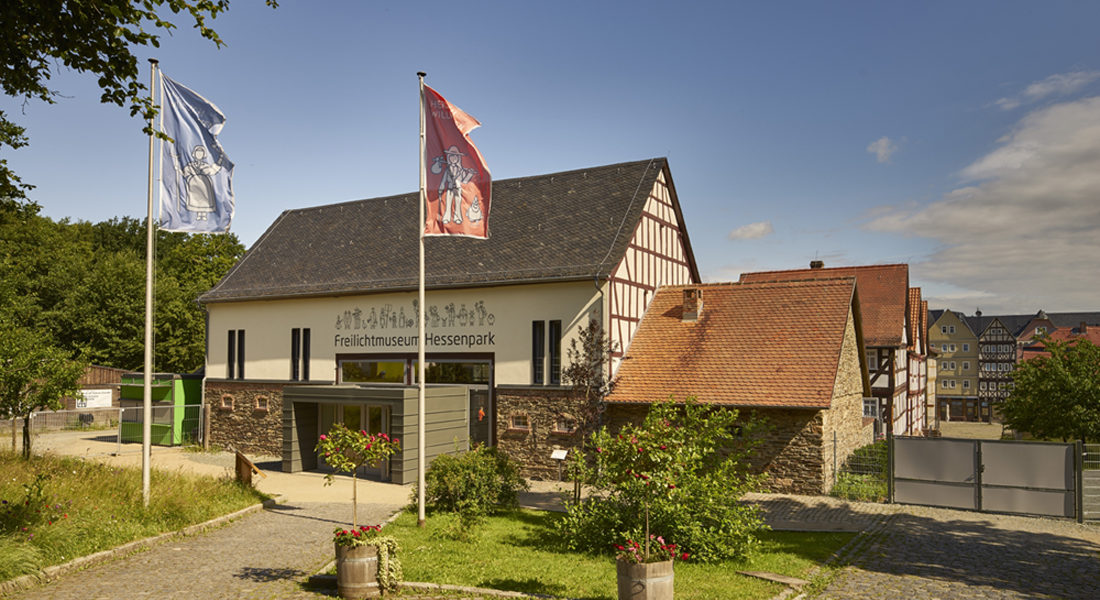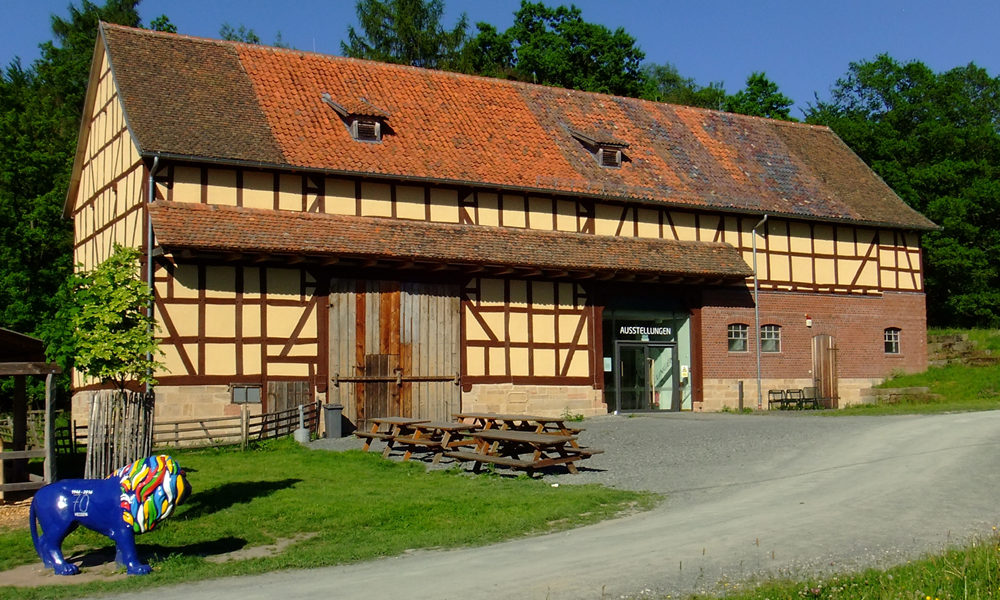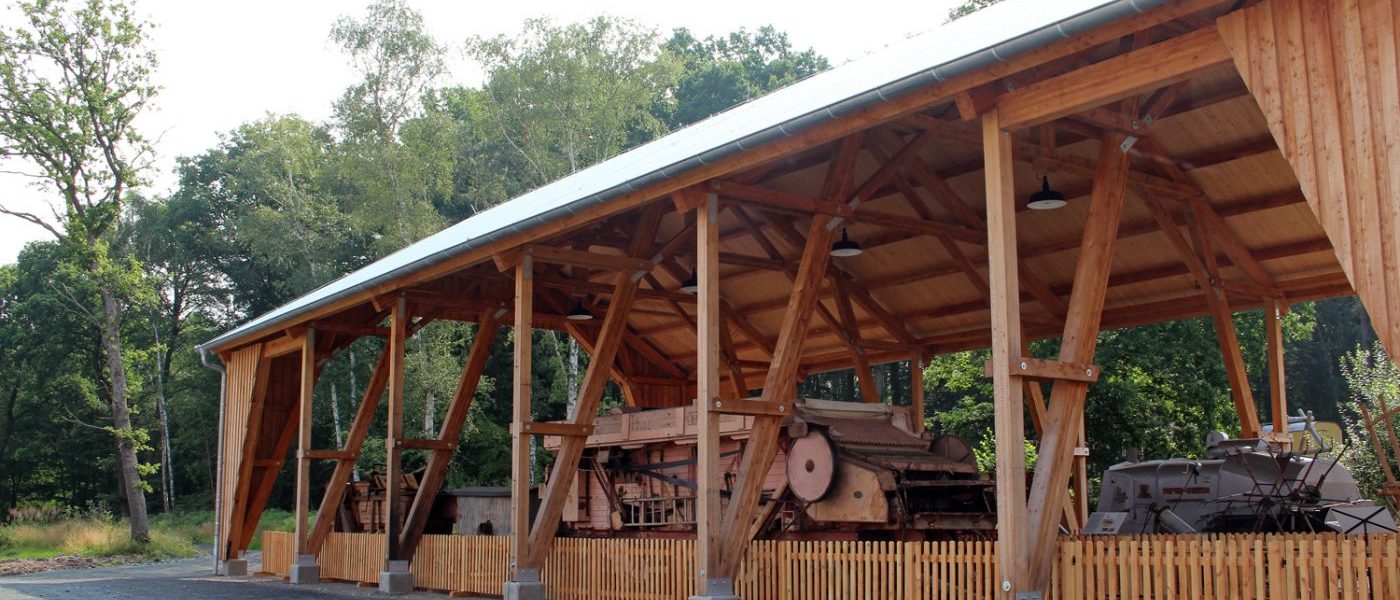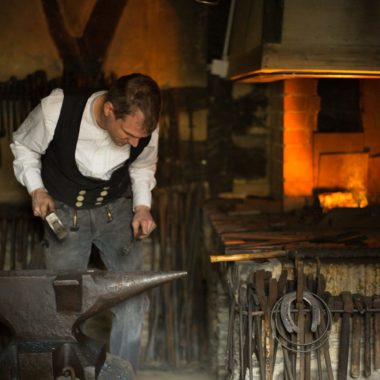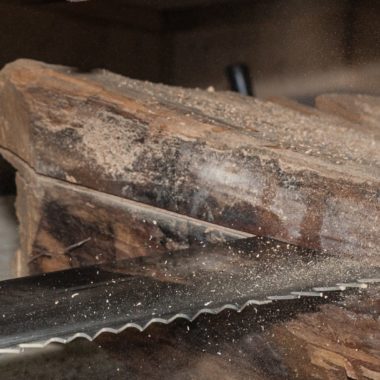
Disabled access at Hessenpark
The Hessenpark grounds cover an area of 65 hectares dedicated to showing how people in Hesse used to live and work. Naturally, our ancestors back then were unfamiliar with the modern concept of “accessibility”. Their living quarters reflected this: The houses were usually cramped, with steep staircases, low ceilings and bad lighting. Roads were usually paved with cobbles or not paved at all. We show the houses in their historic state. Unfortunately, this means that many of them are not easily accessible. Being an open-air museum, Hessenpark does not offer ideal conditions for people with special needs. However, we’ve been doing a lot of work on accessibility and we try to diminish barriers wherever possible as well as to recommend special offers for our visitors with disabilities.

As a matter of fact, wheelchair users can make the most of the rolling terrain when they are accompanied by an assistant to help them with ascents. Wheelchairs can be rented at the ticket office. It is possible to reserve a wheelchair in advance, just call +49 (0) 6081 588-135. Plenty of benches, resting places and toilet facilities fitted for visitors with special needs can be found throughout the museum.
Parking
The museum’s parking lot entails designated parking spaces for people with disabilities. They are located directly besides the entrance building. When bigger events are taking place in Hessenpark, the museum staff helps to direct the cars and makes sure that people having the required authorisation have access to accessible parking.
Toilet facilities
Accessible facilities are flagged in the museum’s map. They are located just besides the entrance building, at the bowling alley behind the house from Idstein, in the stable barn from Asterorde, in the Martinsklause village inn, in the manor house from Solms and at the toilet facilities of the Rhine-Main Ensemble.
Routes and accessibility
The market place and the village road in the Central Hesse Ensemble are cobbled. Furthermore, the water-bound gravel paths of the Hessenpark Open Air Museum can be managed with wheelchairs, walking frames and prams. However, they can become muddy in bad weather, thus making their use more difficult. Also, some of the lanes or forest paths do not allow for easy access.
ENSEMBLES & HISTORICAL BUILDINGS
The roads of the museum ensembles are partly barrier-free. Some of our historic buildings are wheelchair accessible as well. When in doubt, please consult this overview:
Entrance Area and Marekt Square
Disabled parking is located just besides the entrance building. The barn from Westerfeld has been the entrance to Hessenpark since 2015. It is accessible and accommodates – besides the ticket office – a small museum shop with an assortment of choice gifts. Accessible toilet facilities are situated just besides the entrance building.
The whole market place is cobbled. Therefore, it might be demanding to cross the market place for visitors with a walking impairment or in a wheelchair. Nevertheless, the market place can be avoided when turning left just behind the entrance building and taking the gravel path there.
Central Hesse Ensemble
The road leading through the Central Hesse Ensemble is paved with cobblestones, too. On the left side, a part of the road is paved lengthwise, which is a nicer ground for prams, walking frames or wheelchairs than the remaining road, which is paved crosswise. The alternative route leads along the path behind the historical buildings. This means you can access the individual yards from the back of the buildings and examine the houses from outside. The buildings belonging to the Central Hesse Ensemble can only be accessed via stairs and are therefore not barrier-free.
Northern Hesse Ensemble
The stable barn from Asterode, the biggest exhibition building of the Open Air Museum, is part of the Northern Hesse Ensemble. It houses annually changing major exhibitions: In 2018, the topic of the exhibition – due to the 150th anniversary of the Taunusklub – is “Wanderlust. Two hundred years of walking in the Taunus”. The exhibition building is equipped with modern facilities such as an elevator so all storeys are fully accessible. An accessible toilet is located on the first floor. When designing/laying out the exhibition we keep in mind that all exhibition objects should be easily accessible and that the installations still leave enough room for access with wheelchairs and prams.
Accessible toilet facilities are also to be found at the Martinsklause inn. They can be entered from the backside of the building. The taproom itself can unfortunately only be accessed by stairs. During the summer there is outside seating, however, these tables are not serviced. People with special needs would need to depend on an assistant or on other guests.
The threshing hall is accessible as well. It is used as a display depot for agricultural large-scale threshing machines and is home to the autumnal Thanksgiving celebration. A threshing machine and different drives throughout the years from the movable steam engine (locomobile) to the electric engine wagon drawn combine harvester to the self-propelled machine of the 1950s and 1960s are on display.
The room on the left hand of the synagogue from Nentershausen looks just like it must have looked after the renovation of the building in 1925. The interior paintings had been restored back then. This room is accessible..
Eastern Hesse Ensemble
This ensemble is a rather long way from the entrance and can only be reached by unpaved roads. The few buildings making up the ensemble are not easily accessible. A visit to this part of the Open Air Museum might be less rewarding for guests with physical disabilities.
Rhine-Main Ensemble
The stable barn from Anspach is one of the biggest buildings in the Rhine-Main Ensemble. This is where you’ll find the permanent exhibition “Taunus Forest Glassworks”, an exhibition on the production of glass in the Taunus between 1450 and 1700. The finds and findings from several production sites paint a vivid picture of the artistic and technical sophistication of late medieval and early modern Taunus glass production. The whole exhibition space is accessible.
Southern Hesse Ensemble
The synagogue from Groß-Umstadt is located in the Southern Hesse Ensemble. It houses the permanent exhibition “They were here. Jewish Country Life in Southern Hesse”. Up until a short while ago, the synagogue was only accessible via stairs. Now there is a path around the building so people using wheelchairs or walking frames and with prams can easily access the building. Thus, the exhibition rooms on the ground floor are entirely accessible.
Workshop Ensemble
The Störkel sawmill from Anspach looks like it did around 1950. Here you can see fully functioning machines such as the impressive horizontal saw frame from Heringen. On selected dates, the machines can be watched in operation for demonstration. Charts on the topics of sawing and carpentry offer additional information about processing timber. The sawmill can be accessed without having to use stairs and most of the building is accessible as well.






